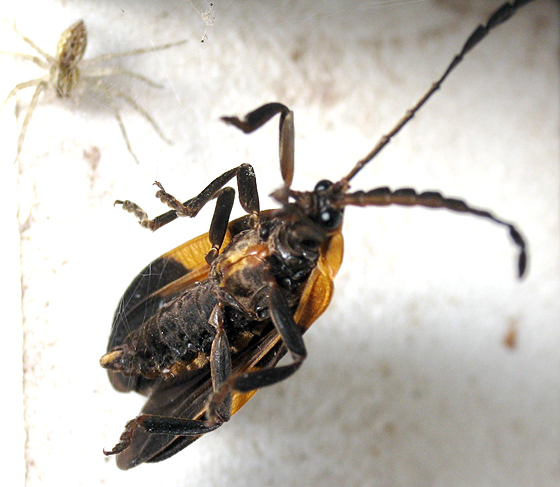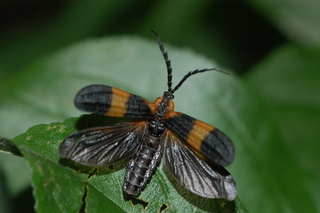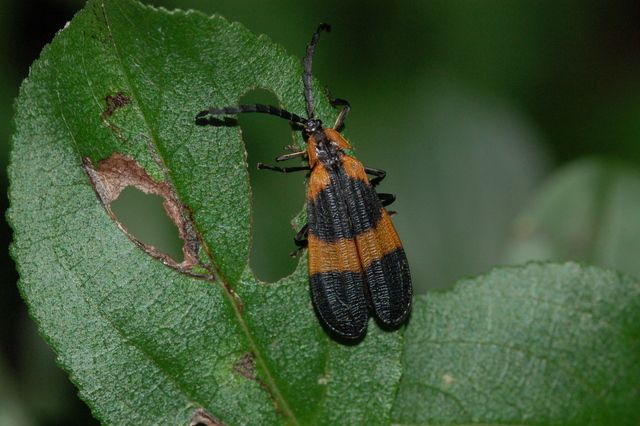Interactions: Don't eat me, I taste bad!
The diet of Calopteron reticulatum larvae is not
completely known. Some researchers record the larvae as being
predacious, feeding on insects,
millipedes, slugs and sowbugs
(Bennett 2012, White 1983), allowing us to see them as a
beneficial insect, however other researchers such as McCabe and
Johnson noted the larvae feeding on fungus, fermenting plant
juices and myxomycetes (Hall and Branham 2008, McCabe and
Johnson 1979). The many different ideas of C. reticulatum’s diet
has caused the Department of Entomology at Ohio State University
to research any predacious nature of the larvae. The study
revealed that if two larvae were put in the same container, then
they would begin attacking each other. This attacking could
however be related to their aggregate prior to pupation because
the larvae is preparing to change. The study went on to observe
the relationship between Anguispira alternata (endodontid snail)
and C. reticulatum, concluding with the larvae consuming the
snail, but it was unknown whether or not the
snail
was alive or
dead (Miller 1988). From this study, scientists can say the
larvae are carnivorous, but in order to classify them as
predacious more studies are needed.
While the larvae are considered carnivorous, adult C.
reticulatum primarily feed on rotting vegetation and fermenting
plant juices. In order to test this beetle’s diet McCabe and
Johnson formed a study with adult Calopteron terminale, a close
neighboring species to C. reticulatum. The C. terminale beetles
used were found on boxelder trees. The study consisted of
withholding food and water from the beetles for three days.
After three days water was provided as well as insect and larvae
that they would have eaten in the larval stage. McCabe and
Johnson (1979) observed the beetles flying away the insects even after
being deprived from food, but when Honey Dew was made available,
the beetles fed freely on the fruit. Knowing that a close
relative to C. reticulatum readily chooses fruit over other
insects allows scientists to make accurate assumptions about C.
reticulatum. Assumptions that can be observed in nature by
setting fruit out to see what bugs come or watching bugs
interact with each other.
food and water from the beetles for three days.
After three days water was provided as well as insect and larvae
that they would have eaten in the larval stage. McCabe and
Johnson (1979) observed the beetles flying away the insects even after
being deprived from food, but when Honey Dew was made available,
the beetles fed freely on the fruit. Knowing that a close
relative to C. reticulatum readily chooses fruit over other
insects allows scientists to make accurate assumptions about C.
reticulatum. Assumptions that can be observed in nature by
setting fruit out to see what bugs come or watching bugs
interact with each other.
Even though the Banded Net-Winged Beetle avoids interaction with
other organisms, it has a large effect on others due to the
bright colorations. Since predators relate the offensive taste
of C. reticulatum to the bright orange bands on its back, many
other organisms have adapted a version of this coloration. This
type of mimicry is known as mullarian mimicry where defenseless
organisms display the same pattern or coloration that an
organism with defenses has. The mimicry is beneficial for other
organisms because they have no chemical defenses; however, the
bright orange coloration fools predators into thinking that the
organism will have a foul taste. The orange and black bands can
be seen in
lightening bug, reticulated beetles,
Soldier beetles,
some leaf beetles, glowworms and many others (White 1983). It is
because of these similarities in variability and appearance of
the bands, that the C. reticulatum is often misidentified (Hall
and Branham 2008).

